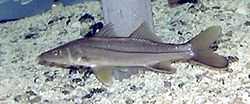Common snook
| Common snook | |
|---|---|
 | |
| Scientific classification | |
| Kingdom: | Animalia |
| Phylum: | Chordata |
| Class: | Actinopterygii |
| Order: | Perciformes |
| Family: | Centropomidae |
| Genus: | Centropomus |
| Species: | C. undecimalis |
| Binomial name | |
| Centropomus undecimalis (Bloch, 1792) | |
The common snook (Centropomus undecimalis) is a species of marine fish in the family Centropomidae of the order Perciformes. The common snook is also known as the sergeant fish or robalo. It was originally assigned to the sciaenid genus Sciaena; Sciaena undecimradiatus and Centropomus undecimradiatus are obsolete synonyms for the species.
One of the largest snooks, Centropomus undecimalis grows to a maximum overall length of 140 centimetres (4.6 ft) but common length is 50 centimetres (1.6 ft).[1] Of typical centropomid form, it possesses drab coloration except for a distinctive black lateral line. It can also possess bright yellow pelvic and caudal fins, especially during spawn.[2]
Distribution and habitat
Centropomus undecimalis is widespread throughout the tropical waters of the western Atlantic Ocean from the coast of the North Carolina to Brazil including the Gulf of Mexico and the Caribbean Sea.[3] Occurring in shallow coastal waters (up to 20 metres (66 ft) depth), estuaries, and lagoons, the fish often enters fresh water. It is carnivorous, with a diet dominated by smaller fishes, and crustaceans such as shrimps, and occasionally crabs.[4]
Human interest
Considered an excellent food fish, the common snook is fished commercially and foreign caught fish are sold in the USA. It is also prized as a game fish, being known for their great fighting capabilities.[5]
Three United States Navy submarines have been named for this species, USS Robalo (SS-273) and USS Snook (SS-279) in the Second World War and USS Snook (SSN-592) in the 1950s.
Protection in Florida Gulf Coast
"At the June 2012 Florida Fish and Wildlife Conservation Commission (FWC) meeting, Commissioners voted to keep the recreational harvest of snook in Gulf of Mexico waters closed through Aug. 31, 2013. This closure will offer the species additional protection after a 2010 cold kill detrimentally affected the population. Snook closed to harvest in Gulf of Mexico and Atlantic waters in January 2010 after a severe cold kill affected snook population number."[6]
This means that all Snook are "Catch and Release" only in the Gulf of Mexico until August 31, 2013. At that time the FWC can choose to open or close Snook harvest for another season. The commercial harvest or sale of Snook is prohibited by the same regulations.
Update: At the June 2013 Florida Fish and Wildlife Conservation Commission (FWC) meeting, Commissioners voted to let the recreational harvest of snook in Gulf of Mexico waters reopen to harvest Sept. 1st. The next stock assessment for snook is scheduled for 2015.[7]
References
- ↑ http://www.fishbase.org/summary/345
- ↑ http://eol.org/pages/205157/details#diagnostic_description
- ↑ http://eol.org/pages/205157/details#distribution
- ↑ http://eol.org/pages/205157/details#trophic_strategy
- ↑ http://eol.org/pages/205157/details#benefits
- ↑ http://myfwc.com/fishing/saltwater/recreational/snook/
- ↑ http://myfwc.com/news/news-releases/2013/june/12/snook-season/
Bibliography
- Froese, Rainer and Pauly, Daniel, eds. (2004). "Centropomus undecimalis" in FishBase. October 2004 version.
- "Centropomus undecimalis". Integrated Taxonomic Information System. Retrieved 2004-12-20.
- Snook or Robalo types as game fish
- Zeigler, Norm (2007). Snook on a Fly: Tackle, Tactics, and Tips for Catching the Great Saltwater Gamefish. Mechanicsburg, PA: Stackpole Books. ISBN 0-8117-0201-4.
- FWC Regulations on snook 2013